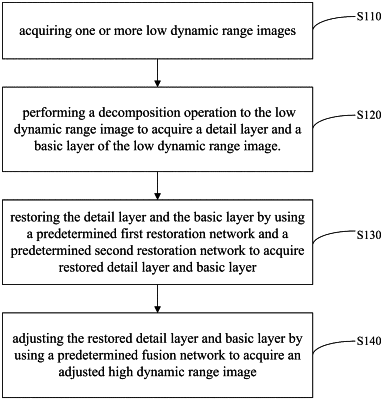| CPC G06T 5/009 (2013.01) [G06T 5/20 (2013.01); G06T 5/50 (2013.01); G06T 2207/10024 (2013.01); G06T 2207/20084 (2013.01); G06T 2207/20192 (2013.01); G06T 2207/20208 (2013.01); G06T 2207/20221 (2013.01)] | 9 Claims |

|
1. A method of inverse tone mapping, comprising steps of:
acquiring one or more low dynamic range images;
performing a decomposition operation to the one or more low dynamic range images to acquire a detail layer and a basic layer of the low dynamic range image;
restoring the detail layer and the basic layer by using a predetermined first restoration network and a predetermined second restoration network to acquire restored detail layer and basic layer, respectively; and
adjusting the restored detail layer and basic layer by using a predetermined fusion network to acquire an adjusted high dynamic range image;
wherein the first restoration network is a residual network and the second first restoration network is a U-Net network;
wherein the residual network comprises one or more convolution layers on both sides and multiple residual blocks in the middle, and each of the residual blocks contains a first convolution layer, a second activation layer, and a third convolution layer and a fourth activation layer arranged in sequence; and before the fourth activation layer further comprises: performing an addition operation on an input image of the residual block and an output image of the third convolution layer; and
wherein the U-Net network comprises multiple convolution blocks and deconvolution blocks, the multiple convolution blocks are located in front of the multiple deconvolution blocks, and each of the multiple convolution block comprises a convolution layer, an activation layer, and a convolution layer and an activation layer arranged in sequence, and in each of the multiple deconvolution blocks, first up-sampling to expand the resolution of the a feature map, and then performing the a convolution operation; each of the multiple deconvolution blocks contains an up- sampling layer and a convolution layer and an activation layer arranged in sequence.
|